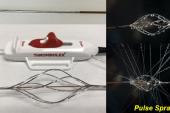Women, Black Patients Less Likely to Get Advanced PE Therapy, Analysis Shows
As a slew of new catheter-based devices hit the market, it will be crucial to keep tabs on eligibility, safety, and access, experts say.

LONG BEACH, CA—Advanced therapies for pulmonary embolism (PE) have been hailed as game changers for patients, but even as more devices are entering or preparing to enter the market, an analysis of real-world data suggests there may be race- and gender-based disparities in who gets access to treatment .
“Advanced PE therapy seems to be vulnerable to disparate use and perhaps underused in aggregate,” said Sahil Parikh, MD (NewYork-Presbyterian/Columbia University Irving Medical Center, New York, NY), who presented the new analysis here at SCAI 2024. “Advanced therapies for PE were performed less often in Black patients, and when advanced therapies were used, the odds of major bleeding was interestingly higher in women and white patients versus Black patients.”
PE interventions are among the fastest growing procedural areas in interventional cardiology, despite the absence of class I, level I evidence for procedural performance and no mandated registries or designated centers of excellence, he added.
The new exploratory analysis, part of the REAL-PE study, used deidentified electronic health records from the Truveta database that included more than 435,000 patients in the United States with a diagnosis of PE between 2018 and 2023. Of those, 2,072 (0.48%) received ultrasound-assisted catheter-directed thrombolysis (EKOS, Boston Scientific) or mechanical thrombectomy (FlowTriever, Inari Medical).
Among the patients who received advanced therapies, 60% were age 60 or older. Men outnumbered women at 53.7% versus 45.7%, and the majority were white, with Black patients accounting for 13%, Asian patients accounting for 0.8%, and American Indian or Alaska Native patients representing just 0.6% of the treated population. In terms of ethnicity, Hispanic or Latino patients made up 5.8% of the total.
Advanced-therapy rates were lower for Black versus non-Black patients (0.37% vs 0.50%) and for women vs men (0.41% vs 0.55%; P < 0.0001 for both). Additionally, in individual comparisons with white men and white women, Black men and Black women were less likely to receive the therapies (P = 0.0002 for both).
“We need to do further assessment to better understand why these [disparities] exist,” Parikh said in a press conference prior to his presentation.
To TCTMD, he said the 0.48% treatment rate is particularly striking given that advanced therapies are chosen in about one in five high-risk PE cases. Conservatively, if 25% of the overall cases analyzed were high risk, the number selected for treatment should have been more than double what the analysis found.
Advanced PE therapy seems to be vulnerable to disparate use and perhaps underused in aggregate. Sahil Parikh
“One thing that strikes me about PE [therapies] is that the utilization must be very different from center to center,” noted panelist Ethan C. Korngold, MD (Providence St. Vincent Medical Center, Portland, OR). As advanced PE therapy continues to proliferate, he said it will be important that centers that offer those therapies “can reach a variety of different patients in a range of backgrounds.”
At the same time, panelist William Brent Keeling, MD (Emory University, Atlanta, GA), said while big data, such as was used in this analysis, may point the way toward demographic problems in access to treatments, “the first test is to figure out who actually benefits from these interventions.”
A ‘Renaissance’ of PE Innovation
Presentations on PE management were widespread at the SCAI meeting, with a recurring theme of who to treat and how, given the explosion of new options. Presenting in the same session, Tai Kobayashi, MD (Hospital of the University of Pennsylvania, Philadelphia), showed early data on a novel PE thrombectomy device (Hēlo; Endovascular Engineering), which features a host of functions from spinning to aspiration and was built to mirror a bronchoscope. He called it a “marriage” between large- and small-bore embolectomy.
“We know that the pulmonary arteries match the anatomy of the bronchus,” Kobayashi told TCTMD. “It is similarly over the wire in terms of its design, but the idea here would be that it has the ability to transit through the heart and lungs in a smaller device, a 16-French system, but it still allows you to expand the funnel to the 24-French size that the other large-bore [PE] devices are currently utilizing.”
In the first-in-human ENGULF study of 25 patients from eight centers, he showed a 23.2% mean reduction from baseline in RV/LV ratio at 48 hours, with no major adverse events and no deaths at 30 days.
Kobayashi said the learning curve for operators using the device is minimal. “I feel very strongly that within three to five cases, you're going to be facile with this particular device,” he said.
Kobayashi noted that a larger trial is currently underway, adding “I think we're seeing a renaissance here that we're living through,” with regard to the entry of PE devices onto the market.
A month ago, the US Food and Drug Administration gave premarket approval to AlphaVac (AngioDynamics), a catheter-directed mechanical thrombectomy device for PE.
Presenting data on that device in the single-arm, investigational device exemption (IDE) APEX AV trial of 122 patients from 25 centers with acute intermediate-risk PE, Keeling said the mean reduction from baseline in RV/LV ratio was 29% at 48 hours, with a 35.5% mean reduction in clot burden and no mortality at 30 days. The study data formed the basis for the FDA’s decision.
“This is a comparable safety and efficacy profile to other catheters in the space,” Keeling noted, adding that in regulatory terms, the bar for entry of new advanced therapy PE devices is low.
“We've seen a number of catheters become FDA approved through this process and I think that's good for patients, but I think postmarket registries and postmarket analysis of these catheters, especially when it comes to safety and efficacy, is going to be of utmost importance,” he added. “I’m a surgeon, but I also use some of these catheter-based therapies. We should be doing more for a lot of these patients, so I agree with the low bar for entry, but . . . [the FDA is] asking us to monitor these devices postmarket.”
L.A. McKeown is a Senior Medical Journalist for TCTMD, the Section Editor of CV Team Forum, and Senior Medical…
Read Full BioSources
Parikh SA. Disparities in pulmonary embolism care: insights from big data analytics. Presented at: SCAI 2024. May 3, 2024. Long Beach, CA.
Kobayashi T. A safety and feasibility single-arm study of a novel catheter thrombectomy device for the treatment of pulmonary embolism (ENGULF). Presented at: SCAI 2024. May 3, 2024. Long Beach, CA.
Keeling WB. APEX-AV: acute pulmonary embolism extraction trial with the AlphaVac system. Presented at: SCAI 2024. May 3, 2024. Long Beach, CA.
Disclosures
- Parikh reports institutional research support from Abbott Vascular, Veryan Medical, Acotec, Concept Medical, Shockwave Medical, TriReme Medical, Surmodics, Boston Scientific, and Reflow Medical; serving on advisory boards for Abbott, Medtronic, Boston Scientific, Cordis, and Philips; and consulting for Terumo, Abiomed, Penumbra, Canon, Recor, and R3 Vascular.
- Keeling reports consulting for, serving on the advisory board and speakers bureau of AngioDynamics.
- Kobayashi reports serving on advisory boards for Recor, Medtronic, and Sonivie.





Comments